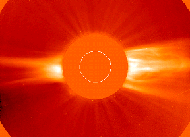Bubble, Bubble, Toil and Trouble
Looking at the sky, you would think the Sun is static, placid,
constant. From the ground, the only features that seem to change
are where and when the Sun will appear: will clouds block its rays
today? Will it rise at 6:30 or 7:30 a.m.? But while our Sun does
give us a steady stream of warmth and light, it also has weather
that is turbulent and dynamic, provoking the cosmic equivalent of
winds, clouds, waves, precipitation, and storms.
The Sun is a huge thermonuclear reactor, fusing hydrogen atoms
into helium and producing million degree temperatures and intense
magnetic fields. Near its surface, the Sun is like a pot of
boiling water, with bubbles of hot, electrified gas-actually
electrons and protons in a fourth state of matter known as
plasma-circulating up from the interior, rising to the surface,
and bursting out into space. The steady stream of particles
from the Sun is known as
the solar wind.
Blowing at 800,000 to 5 million miles per hour, the solar wind
carries a million tons of matter into space every second (that's
the mass of Utah's Great Salt Lake). It's not the mass or speed,
however, that makes the solar wind potent. In fact, the solar wind
would not even ruffle the hair on your head because there are too
few particles in the breeze (our air is millions of times denser
than the solar wind). Instead, it is the energy stored in the
plasma and the magnetic fields associated with that plasma that
allow the wind to shape and impact Earth's protective magnetic
shield in space (the magnetosphere). Though less than 1% of the
solar wind penetrates the magnetosphere, that's enough to generate
millions of amps of electric current in our atmosphere and to cause
occasional magnetic storms in the space around Earth.
If the character of the solar wind is like that of the winds
on Earth-mild, steady, and global-then sunspots and solar flares
are like lightning and tornadoes-potent, but only over a small
area. Sunspots are dark splotches on the Sun caused by the
appearance of cooler (3000 degrees Celsius) areas amidst the
roiling gases on the surface (6000 degrees C). These areas are
cooler because much of their energy is tied up in intense magnetic
fields that are 1000 times stronger than the magnetic field of Earth.
On the other hand, solar flares appear as explosive bright spots
on the surface of the Sun. Flares occur when magnetic energy built
up in the solar atmosphere near a sunspot is suddenly released in a
burst equivalent to ten million volcanic eruptions.
Radiation-including radio waves, X rays, and gamma rays-and
charged particles may strike the Earth following a solar flare
(though most of the particles are deflected by Earth's magnetic
field). The strongest flares occur just several times per year,
while weaker flares are relatively common, with as many as a dozen
a day during the Sun's most active periods.
NEXT PANEL: Hurricane
Sol
|



